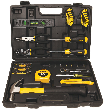Installing a Deadbolt in an Aluminum Door
One of the most basic methods people have for keeping their home safe and secure from intruders is through the use of a deadbolt lock. In fact, this method is so basic that it has pretty much become a standard fixture on newer homes. However, what do you do if you have home that does not have a deadbolt? The answer to this question is that you simply install a deadbolt yourself, even if you have one of those new aluminum doors. Installing a deadbolt in an aluminum door is a fairly easy task that even the most novice of home improvement enthusiasts can do, here's how.
- Inspect the door. Before you begin, you need to make sure that you inspect your door. Make sure that it is in good working condition. While checking your door, make note of whether your door is a right hand, or left hand door. Surprisingly this will effect what type of deadbolt you purchase. If you stand outside your door, looking in and you see the hinges on the left side of the door, it is a left hand door. Obviously, if the hinges are on the right hand side of the door, you have a right hand door.
- Choose the lock. The easiest kind of deadbolt to install is known as an external deadbolt. This type of lock is not placed inside the door itself, but rather attached to the door, and requires less work to install. When choosing your lock, make sure that you choose the proper (left or right hand) lock for your door.
- Place the template. The deadbolt kit will include a template for the lock itself. Hold this template against the door, to ensure that you find the proper placement for your new deadbolt. While holding the template against the door, mark where you will be drilling holes to hold the deadbolt. Make sure that you have the template level while doing this, or your deadbolt will be crooked.
- Drill the holes. When drilling the holes, make sure that you properly follow the manufacturer's directions. Do not drill all the way through, and that you are using the proper drill bit.
- Attach the lock. Follow the manufacturer's directions when attaching the lock itself. Be sure that you have the door open as you do this since it will be easier for you to be able to access your work area.
- Attach the strike plate. After attaching the lock, it is time to attack the strike plate. Once again, follow the directions that the manufacturer provided for your particular lock; however, you will want to do this with the door closed. This way, you can ensure that you have everything properly lined up.
- Test the lock. Once everything has been attached properly, all that is left to do is test the lock. Close the door, and lock the deadbolt. If you have done your work properly, you should be able to close the deadbolt with no problem at all. If not, then it may be necessary to make a few adjustments until everything has been lined up properly.
Author Bio
Doris Donnerman
Doris is a jack of all trades, writing on a variety of topics. Her articles have helped enlighten and entertain thousands over the years. Learn more about Doris...
Using Your Clothes Dryer
While drying your clothes is simple and a basic step in doing your laundry, there are a few tips you should keep in mind ...
Discover More
Deodorizing Dishcloths
Dishcloths and scrubbies have a tendency to smell pretty quickly once they have started to be used. Getting rid of that ...
Discover More
Cleaning a Car Headlight
The headlights of cars are made of plastic, and overtime they will become yellow and dirty looking. When this happens, ...
Discover More
More Home Improvement Tips
Refinishing Doors
Instead of completely replacing a door, and spending loads of money that could be better used on a different project, why ...
Discover More
Fixing a Loose Doorknob
Fixing a loose doorknob is a very useful skill that is easily acquired. Your family and neighbors will thank you for ...
Discover More
Installing a Prehung Entry Door
Whether you are looking to make your home a little more energy efficient, or you simply want a change, installing a ...
Discover More

Comments